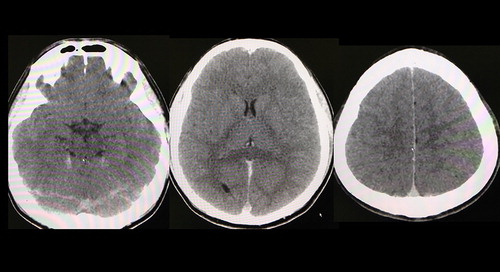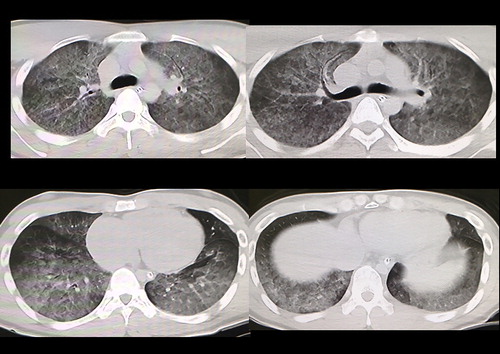Abstract
A 20-year-old man was found by his family in a state of cardiac arrest. His face was covered with a plastic bag connected to a helium tank through a hose. Although advanced cardiac life support was performed, resuscitation attempts were unsuccessful. Computed tomography from his head to pelvis demonstrated diffuse brain swelling and lung edema. The massive inspiration of pure helium gas and/or hypoxia appeared to have induced lung edema by breaching the blood gas barrier in the lung.
1. Introduction
Helium is a light, odorless, tasteless, and colorless noble gas with a strong safety profile except for oxygen deficiency. It has multiple applications in medicine [Citation1]. Helium is commercially available. Helium/oxygen mixture (HeliOx) is used to prevent nitrogen narcosis or the bends in deep-sea divers. Helium has not been shown to have an anesthetic or narcotic effect on divers at depth breathing compressed gases [Citation2]. People may use it to alter their voices at a party or inflate balloons. Inhaling helium rarely but occasionally results in rupturing of alveoli, pneumomediastinum, or embolization [Citation3, Citation4]. We herein present the computed tomography (CT) findings of asphyxial suicide by the inhalation of helium inside a plastic bag.
2. Case presentation
The protocol of this retrospective case study was approved by the review board of Juntendo Shizuoka Hospital, and all examinations were conducted according to the standards of good clinical practice and the Helsinki Declaration.
A 20-year-old male, who had shown a pessimistic outlook, dropped out of college, cancelled his apartment contract, and continually remained inside his home. His family found him in a state of cardiac arrest. A plastic bag connected to a helium tank through a hose, covered his face. When emergency technicians reached him, his initial rhythm was asystole. After securing his airway by an endotracheal tube and an infusional administration of adrenalin through the venous route, the patient was transferred to our hospital. However, resuscitation attempts were unsuccessful. Computed tomography from his head to pelvis demonstrated diffuse brain swelling and lung edema within a few minutes after termination of resuscitation ( and ). His body was transferred to the police department to investigate his death according to the Japanese law. However, an autopsy was not performed.
3. Discussion
This case demonstrated marked brain swelling and lung edema. Brain swelling induced by hypoxia is frequently observed, particularly in patients under cardiopulmonary arrest. However, hypoxia does not always induce lung edema. One of the mechanisms underlying hypoxia-induced lung edema is pulmonary vasoconstriction that occurs with prolonged exposure to hypoxia [Citation5]. Pulmonary vascular pressures subsequently increase and can stress the delicate alveolar capillary barrier and induce mechanical stress failure. This pulmonary vascular response likely has multiple driving mechanisms involving the sympathetic tone, elevated endothelin 1 levels, or decreased levels of exhaled nitric oxide [Citation5]. These complicated mechanisms may result in differences in the susceptibility of lungs to hypoxia. Although helium is nontoxic, it should still be considered dangerous, as any gas breathed at near 100% saturation can cause hypoxia/anoxia. Autopsy findings in a similar case also revealed cerebral swelling and lung edema by helium [Citation6]. Another possible mechanism underlying the lung edema in the present case was negative pressure pulmonary edema [Citation6–9], which can rarely develop in patients with labored breathing in association with upper airway obstruction, subsequently inducing alveolar damage. The upper airway obstruction due to the plastic bag in the present case can cause negative pressure lung edema [Citation6–9]. Yoshitome et al. previously reported a case of hypoxial death due to helium gas when a drunken 14-year-old boy inserted the upper half of his body into an advertising balloon filled with helium gas [Citation10]. It seems difficult to confirm whether this case was an accident or suicide attempt [Citation10]. The autopsy findings of this case also revealed marked lung edema, although the upper airway remained clear. Accordingly, the massive inspiration of pure helium gas and/or hypoxia appears to have induced lung edema by breaching the blood gas barrier in the lung.
Recently, increasing trends of suicide through the inhalation of helium gas, probably due to the influence of the Internet, have been reported [Citation11, Citation12]. An Ichushi search (Japana Centra Revuo Medicine), which collects summaries of Japanese medical articles, was performed to identify articles from 1964 to 2018 using the keyword “helium”. We ultimately found five case reports of patients who became symptomatic by exposure to helium, excluding any diving-related reports () [Citation10, Citation13–16]. Three of these five cases were suicide attempts, and all three reports were published after 2016. This reflects the fact that suicide attempts by helium have recently been increasing in frequency in Japan. The rate of suicidal death using sulfate suddenly increased from 29 in 2007 to 1056 in 2008 due to the publication on the Internet of information on how to die using sulfate and mass media reports based on white paper of suicide countermeasures from the Cabinet Office, Government of Japan in 2011 [Citation17]. The National Police Agency & Ministry of Health, Labor and Welfare thus established regulations on the sale of sulfate and information on sulfate’s use for suicide attempts on the Internet and in the media in 2008 [Citation18]. With the introduction of these efforts, the rate of suicide using sulfated dramatically decreased [Citation19]. Accordingly, to prevent suicide through the inhalation of helium gas, the commercial availability of helium and information on how to commit suicide using helium on the Internet should be more strictly regulated.
Table 1. Case reports of patients who became symptomatic due to helium exposure, excluding diving.
Disclosure statement
No potential conflict of interest was reported by the author.
References
- Berganza CJ, Zhang JH. The role of helium gas in medicine. Med Gas Res. 2013;3:18
- Kirkland PJ, Cooper JS. Diving, nitrogen narcosis. StatPearls [Internet]. Treasure Island (FL): StatPearls Publishing; 2018.
- Zaia BE, Wheeler S. Pneumomediastinum after inhalation of helium gas from party balloons. J Emerg Med. 2010;38:155–158.
- Tretjak M, Gorjup V, Mozina H, et al. Cerebral and coronary gas embolism from the inhalation of pressurized helium. Crit Care Med. 2002;30:1156–1157.
- Sheppard RL, Swift JM, Hall A, et al. The influence of CO2 and exercise on hypobaric hypoxia induced pulmonary edema in rats. Front Physiol. 2018;9:130. DOI:10.3389/fphys.2018.00130.eCollection2018.
- Schön CA, Ketterer T. Asphyxial suicide by inhalation of helium inside a plastic bag. Am J Forensic Med Pathol. 2007;28:364–367.
- Shukla D, Saxena S, Purushothaman J, et al. Hypoxic preconditioning with cobalt ameliorates hypobaric hypoxia induced pulmonary edema in rat. Eur J Pharmacol. 2011;656:101–109.
- . Omori K, Yanagawa Y, Inoue T, et al. Pulmonary edema induced after being buried alive. Am J Emerg Med. 2015;33:1711.e1-2
- Pessanha LB, de Melo AM, Braga FS, et al. Acute post-tonsillectomy negative pressure pulmonary edema. Radiol Bras. 2015;48:197–198.
- Yoshitome K, Ishikawa T, Inagaki S, et al. A case of suffocation by an advertising balloon filled with pure helium gas. Acta Med Okayama. 2002;56:53–55.
- Chang SS, Cheng Q, Lee ES, et al. Suicide by gassing in Hong Kong 2005-2013: emerging trends and characteristics of suicide by helium inhalation. J Affect Disord. 2016;192:162–166.
- Gallagher KE, Smith DM, Mellen PF. Suicidal asphyxiation by using pure helium gas: case report, review, and discussion of the influence of the internet. Am J Forensic Med Pathol. 2003;24:361–363.
- Kato F, Hiraizumi S, Okada M, et al. A case of successful resuscitation after helium gas inhalation. Chudoku Kenkyu. 2017;30:251–253.
- Hayashi M, Karino K, Watanabe H, et al. Suicide using helium gas. Chubu J Jpn Asso Acute Med. 2017;13:12–14. (In Japanese)
- Yamaura E, Matsuda K, Kikuchi H, et al. A case of suicide by helium gas. Chudoku Kenkyu. 2016;29:355–359.
- Doi H, Nagasaki H, Yamakawa K, et al. Cerebral gas embolism resulting from inhalation of canned pressurized helium-oxygen. J Jpn Soc Hyperbaric Undersea Med. 2016;51:1–6. (In Japanese)
- Ishizawa F. Gas-poisoning affected by the internet. Chudoku Kenkyu. 2011;24:3–8. (In Japanese)
- Office of Chemical Safety, Ministry of Health, Labor and Welfare. Safety measure against improper use of lime sulfur. Chudoku Kenkyu. 2010;23:170–171. In Japanese
- Takizawa T, Sakamoto S, Sueki S. Did the suicide by hydrogen sulfide end in Japan?: Consideration from the point of view of toxic effect of hydrogen sulfide (T59.6) of vital statistics. J Jpn Asso Suicide Prev. 2015;35:41–47. (In Japanese)


